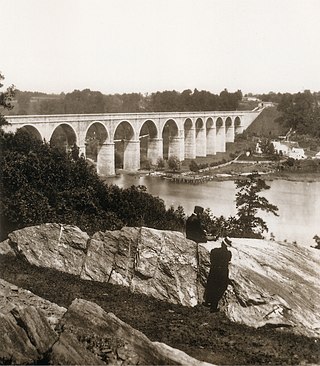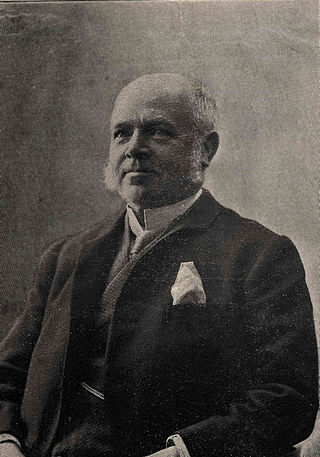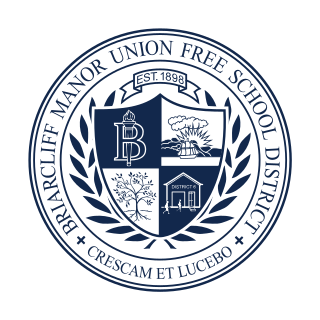
Briarcliff Manor is a suburban village in Westchester County, New York, 30 miles (50 km) north of New York City. It is on 5.9 square miles (15 km2) of land on the east bank of the Hudson River, geographically shared by the towns of Mount Pleasant and Ossining. Briarcliff Manor includes the communities of Scarborough and Chilmark, and is served by the Scarborough station of the Metro-North Railroad's Hudson Line. A section of the village, including buildings and homes covering 376 acres (152 ha), is part of the Scarborough Historic District and was listed on the National Register of Historic Places in 1984. The village motto is "A village between two rivers", reflecting Briarcliff Manor's location between the Hudson and Pocantico Rivers. Although the Pocantico is the primary boundary between Mount Pleasant and Ossining, since its incorporation the village has spread into Mount Pleasant.

Yorktown is a town on the northern border of Westchester County, New York, United States. A suburb of the New York City metropolitan area, it is approximately 38 miles (61 km) north of midtown Manhattan. The population was 36,569 at the 2020 U.S. Census.

Ossining is a village in Westchester County, New York, United States. The population at the 2020 United States census was 27,551, an increase from 25,060 at the 2010 census. As a village, it is located in the town of Ossining.

Ossining is a town located along the Hudson River in Westchester County, New York. The population was 40,061 at the time of the 2020 census. It contains two villages, the Village of Ossining and part of Briarcliff Manor, the rest of which is located in the Town of Mount Pleasant. Ossining is the location of Sing Sing maximum-security prison.
Northern Westchester refers to the upper portion of Westchester County, New York, a suburban area north of New York City. Lying north of Interstate 287/Cross Westchester Expressway, these communities are distinguished by distance from New York City and their more rural character from those of Southern Westchester. The area is notable for its general affluence and high degree of watershed for New York City, being home to two major collection reservoirs supplying drinking water to it, the New Croton and Kensico.

Montrose is a hamlet within the town of Cortlandt, in the northwestern corner of Westchester County, New York, United States. It is located near Croton-on-Hudson and Buchanan. The rural character of the hamlet is defined by the Hudson River, numerous wooded hills and steep slopes, wetland areas and beautiful streams. As of the 2010 census, Montrose had a population of 2,731.

The Croton Aqueduct or Old Croton Aqueduct was a large and complex water distribution system constructed for New York City between 1837 and 1842. The great aqueducts, which were among the first in the United States, carried water by gravity 41 miles (66 km) from the Croton River in Westchester County to reservoirs in Manhattan. It was built because local water resources had become polluted and inadequate for the growing population of the city. Although the aqueduct was largely superseded by the New Croton Aqueduct, which was built in 1890, the Old Croton Aqueduct remained in service until 1955.

Briarcliff High School (BHS) is a public secondary school in Briarcliff Manor, New York that serves students in grades 9–12. It is the only high school in the Briarcliff Manor Union Free School District, sharing its campus with Briarcliff Middle School. As of 2021, the principal is Diana Blank and the assistant principal is Daniel Goldberg.

Ossining High School (OHS) is a comprehensive public high school located in Ossining, New York, United States, along the Hudson River in northern Westchester County, New York. Serving grades 9 through 12, it is the sole high school within the Ossining Union Free School District. The school serves the entirety of the village of Ossining, portions of the Village of Briarcliff Manor, Town of Ossining, and Town of New Castle, as well as a very small southern portion of the Town of Yorktown.

The Downtown Ossining Historic District is located at the central crossroads of Ossining, New York, United States, and the village's traditional business district known as the Crescent. Among its many late 19th- and early 20th-century commercial buildings are many of the village's major landmarks—three bank buildings, four churches, its village hall, former post office and high school. It was recognized as a historic district in 1989 and listed on the National Register of Historic Places, as one of the few downtowns in Westchester County with its social and historical development intact.

The Scarborough Historic District is a national historic district located in the suburban community of Scarborough-on-Hudson, in Briarcliff Manor, New York. The 376-acre (152 ha) district was added to the National Register of Historic Places in 1984, and contains seven historically and architecturally significant properties dating from the late 18th century to the early 20th century. Most of the properties are domestic, or used for education or religion. The most common architectural styles within the district are Mid-19th Century Revival and Late Victorian.

This is a list of the National Register of Historic Places listings in northern Westchester County, New York, excluding the city of Peekskill, which has its own list.

Walter William Law was a businessman and the founder of the 8,000-person village of Briarcliff Manor, New York. He was a vice president of furniture and carpet retailer W. & J. Sloane, and later founded the Briarcliff Lodge, the Briarcliff Table Water Company, Briarcliff Farms, and the Briarcliff Greenhouses. He founded or assisted in establishing several schools, churches, and parks in the village, and rebuilt its train station in 1906. In the early 1900s, Walter Law was the largest individual landholder in Westchester County.

The Briarcliff Manor Fire Department (BMFD) provides fire protection and emergency medical services to the village of Briarcliff Manor, New York and its hamlet Scarborough. The volunteer fire department also serves unincorporated areas of Ossining and Mount Pleasant. The fire department has three fire companies, two stations, and four fire engines; it also maintains other vehicles, including a heavy rescue vehicle. The Briarcliff Manor Fire Department Ambulance Corps provides emergency medical transport with two ambulances. The fire department is headquartered at the Briarcliff Manor Village Hall, with its other station in Scarborough, on Scarborough Road.

The Briarcliff Lodge was a luxury resort in the village of Briarcliff Manor, New York. It was a notable example of Tudor Revival architecture, and was one of the largest wooden structures in the United States. It was also the first hotel in Westchester County. Walter William Law had it built on his estate, and the Law family owned it until 1937. When the lodge opened in 1902, it was one of the largest resort hotels in the world. The lodge hosted presidents, royalty, and celebrities, and was the scene of numerous memorable occasions for visitors and local residents who attended weddings, receptions, and dances in the ballroom and dining room. For a long time, the lodge was situated among other businesses of Walter Law, including the Briarcliff Farms and Briarcliff Table Water Company.

The Briarcliff Manor Union Free School District is the public school district of Briarcliff Manor, New York. The district is an independent public entity, and is governed by the district Board of Education, whose members are elected in non-partisan elections for staggered, three-year terms. The board selects a superintendent, who is the district's chief administrative official. The district's offices are located in Todd Elementary School.

The history of Briarcliff Manor, a village in the county of Westchester, New York, can be traced back to the founding of a settlement between the Hudson and Pocantico Rivers in the 19th century. The area now known as Briarcliff Manor had seen human occupation since at least the Archaic period, but significant growth in the settlements that are now incorporated into the village did not occur until the Industrial Revolution. The village, which was incorporated with one square mile in 1902, has expanded primarily through annexation: of Scarborough in 1906 and from the town of Mount Pleasant in 1927.

Archville is a hamlet in Mount Pleasant in Westchester County, New York, United States. The hamlet consists of residences, businesses, and a fire station on Union Street, Arch Hill, and Requa Street, all abutting U.S. Route 9. Directly across Route 9 lies Rockwood Hall, part of the Rockefeller State Park Preserve. The volunteer Archville Fire Department serves the hamlet and surrounding area, from the Hudson River to Pocantico Lake and from the edge of Briarcliff Manor to the edge of Sleepy Hollow.
The history of Briarcliff Manor, a village in Westchester County, New York, can be traced back to the founding of a settlement between the Hudson and Pocantico Rivers in the 19th century. The area now known as Briarcliff Manor had seen human occupation since at least the Archaic period, but significant growth in the settlements that are now incorporated into the village did not occur until the Industrial Revolution. The village, which was incorporated with one square mile in 1902, has expanded primarily through annexation: of Scarborough in 1906 and from the town of Mount Pleasant in 1927 to its current area of 6.7 square miles (17 km2). The village has also grown in population; from 331 when established to 7,867 in the 2010 census.

The Briarcliff Manor Public Library is the public library serving the village of Briarcliff Manor, New York, and is located on the edge of the Walter W. Law Memorial Park. The library is a founding member of the Westchester Library System. It is staffed by a director and eleven employees, including reference and youth librarians, and is governed by a ten-member board, with a liaison to the village board of trustees. The library offers computer classes, book discussion groups, young adult programs, a children's room and a local history collection. The library building also houses the Briarcliff Manor-Scarborough Historical Society, the Briarcliff Manor Recreation Department, and the William J. Vescio Community Center.




















